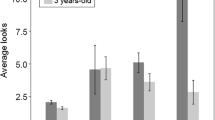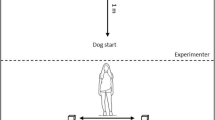Abstract
Understanding animals’ abilities to cooperate with and learn from each other has been an active field of research in recent years. One important basis for all types of social interactions is the disposition of animals to pay attention to each other—a factor often neglected in discussions and experiments. Since attention differs between species as well as between individuals, it is likely to influence the amount and type of information different species and/or observers may extract from conspecifics in any given situation. Here, we carried out a standardized comparative study on attention towards a model demonstrating food-related behavior in keas, dogs and children. In a series of experimental sessions, individuals watched different conspecific models while searching, manipulating and feeding. Visual access to the demonstration was provided by two observation holes, which allowed us to determine exactly how often and for how long observers watched the model. We found profound differences in the factors that influence attention within as well as between the tested species. This study suggests that attention should be incorporated as an important variable when testing species in social situations.




Similar content being viewed by others
References
Anderson DR, Levin SR (1976) Young children’s attention to “Sesame Street”. Child Dev 47:806–811
Byrne RW, Russon AE (1998) Learning by imitation: a hierarchical approach. Behav Brain Sci 21:667–721
Choleris E, Guo C, Liu HF, Mainardi M, Valsecchi P (1997) The effect of model age and number on duration of socially-induced food preferences in house mouse (Mus domesticus). Behav Processes 41:69–77
Choleris E, Kavaliers M (1999) Social learning in animals: sex differences and neurobiological analysis. Pharmacol Biochem Behav 64:767–776
Cohen LB (1972) Attention-getting and attention-holding processes of infant visual preferences. Child Dev 43:869–875
Day RL, Coe RL, Kendal JR, Laland KN (2003) Neophilia, innovation and social learning: a study of intergeneric differences in callitrichid monkeys. Anim Behav 65:559–571
Diamond A (1991) Neuropsychological insights in into the meaning of object concept development. In: Carey S, Gelman R (eds) The epigenesis of mind: essays on biology and cognition. Erlbaum, Hillsdale
Diamond J, Bond AB (1991) Social behavior and the ontogeny of foraging in the kea (Nestor notabilis). Ethology 88:128–144
Diamond J, Bond AB (1999) Kea, bird of paradox: the evolution and behavior of a New Zealand parrot. University of California Press, Berkley
Fragaszy D, Visalberghi E (1990) Social processes affecting the appearance of innovative behaviours in capuchin monkeys. Folia Primatol 54:155–165
Fragaszy D, Visalberghi E (2004) Socially biased learning in monkeys. Learn Behav 32:24–35
Gajdon GK, Stauffacher M (2001) Social influence on early foraging of domestic chicks (Gallus gallus). In: Oester H, Wyss C (eds) 6th European symposium on poultry welfare. Druckerei Arm, Bern, pp 254–260
Ginsburg BE (1991) Origins and dynamics of social organization in primates and wolves: cooperation, aggression and hierarchy. In: Somit A, Wildenmann R (eds) Hierarchy and democracy. Nomos Verlagsgesellschaft, Baden-Baden, pp 45–62
Hare B, Brown M, Williamson C, Tomasello M (2002) The domestication of social cognition in dogs. Science 298:1634–1636
Howes C (1988) Peer interaction of young children. Monogr Soc Res Child Dev 53 (1, serial no. 217)
Huber L, Rechberger S, Taborsky M (2001) Social learning affects object exploration and manipulation in keas, Nestor notabilis. Anim Behav 62:945–954
Kubinyi E, Topal J, Miklosi A, Csanyi V (2003) Dogs (Canis familiaris) learn from their owners via observation in a manipulation task. J Comp Psychol 117:156–165
McConnell PB, Baylis JR (1985) Interspecific communication in cooperative herding—acoustic and visual signals from human shepherds and herding dogs. Z F Tierpsych J Comp Ethol 67:302–328
Menzel EW (1973) Leadership and communication in young chimpanzees. In: Menzel EW (ed) Precultural primate behaviour. Karger, Basel, pp 192–225
Menzel EW (1974) A group of young chimpanzees in a one acre-field. In: Schrier AM, Stollnitz F (eds) Behaviour of nonhuman primates. Academic Press, New York, pp 83–153
Miklosi A, Kubinyi E, Topal J, Gacsi M, Zs Viranyi, Csanyi V (2003) A simple reason for a big difference: wolves do not look back at humans but dogs do. Curr Biol 13:763–767
Miklosi A, Polgardi R, Topal J, Csanyi V (2000) Intentional behaviour in dog-human communication: an experimental analysis of “showing” behaviour in the dog. Anim Cogn 3:159–164
Miklosi A, Soproni K (2006) A comparative analysis of animals’ understanding of the human pointing gesture. Anim Cogn 9:81–93
Mineka S, Cook M (1988) Social learning and acquisition of snake fear responses in monkeys. In: Zentall TR, Galef BG Jr (eds) Social learning: psychological and biological perspectives. Lawrence Erlbaum, Hillsdale, pp 51–73
Moscovice LR, Snowdon CT (2006) The role of social context and individual experience in novel task acquisition in cottontop tamarins, Saguinus oedipus. Anim Behav 71:933–943
Nicol CJ, Pope SJ (1999) The effects of model social status and prior foraging success on social learning in laying hens. Anim Behav 57:163–171
Nishida T (1987) Local traditions and cultural transmission. In: Smuts BB, Cheney D, Seyfarth R, Wrangham R, Struhsaker T (eds) Primate societies. University of Chicago Press, Chicago, pp 462–474
Pongracz P, Miklosi A, Kubinyi E, Gurobi K, Topal J, Csanyi V (2001) Social learning in dogs: the effect of a human model on the performance of dogs in a detour task. Anim Behav 62:1109–1117
Pongracz P, Miklosi A, Timar-Geng K, Csanyi V (2004) Verbal attention getting as a key factor in social learning between dog (Canis familiaris) and human. J Comp Psychol 118:375–383
Porges SW, Smith KM (1980) Defining hyperactivity: psychophysiological behavioral strategies. In: Whalen CK, Henker B (eds) Hyperactive children: the social ecology of identification and treatment. Academic Press, New York, pp 75–104
Range F, Huber L (2007) Attention of common marmosets–implications for social learning experiments. Anim Behav 73:1033–1041
Range F, Viranyi Zs, Huber L (2007) Selective imitation in domestic dogs. Curr Biol 17:868–872
Rubin KH, Bukowski W, Parker JG (1997) Peer interactions, relationships and groups. In: Damon W, Eisenberg N (eds) Handbook of child psychology. Wiley, New York
Ruff HA, Lawson KR (1990) Development of sustained, focused attention in young children during free play. Dev Psychol 26:85–93
Ruff HA, Rothbart MK (1996) Attention in early development. Themes and variations. Oxford University Press, Oxford
Scheid C, Range F, Bugnyar T (2007) When what and whom to watch? quantifying attention in ravens and jackdaws. J Comp Psychol 121:380–386
Tebbich S, Taborsky M, Winkler H (1996) Social manipulation causes cooperation in keas. Anim Behav 52:1–10
Tomasello M (1999) The cultural origins of human cognition. Harvard University Press
Tomasello M, Carpenter M, Call J, Behne T, Moll H (2005) Understanding and sharing intentions: the origins of cultural cognition. Behav Brain Sci 28:691–735
Valsecchi P, Bosellini I, Mainardi D, Mainardi M (1993) Further analysis of a case of social-learning in the house mouse (Mus-Domesticus). Ethol Ecol Evol 5:121–125
Zs Viranyi, Topal J, Miklosi A, Csanyi V (2006) A nonverbal test of knowledge attribution: a comparative study on dogs and children. Anim Cogn 9:13–26
Visalberghi E, Addessi E (2000a) Response to changes in food palatability in tufted capuchin monkeys, Cebus apella. Anim Behav 59:231–238
Visalberghi E, Addessi E (2000b) Seeing group members eating a familiar food enhances the acceptance of novel foods in capuchin monkeys. Anim Behav 60:69–76
Visalberghi E, Sabbatini G, Stammati M, Addessi E (2003) Preferences towards novel foods in Cebus apella: the role of nutrients and social influences. Physiol Behav 80:341–349
Warner RR (1988) Traditionality of mating preferences in a coral reef fish. Nature 335:719–721
Washburn DA, Baker LA (2006) Attention as it is manifested across species. In: Wasserman EA, Zentall TR (eds) Comparative cognition. Experimental explorations of animal intelligence. Oxford University Press, Oxford, pp 127–142
Acknowledgments
This work has received research funding from the European Community’s Sixth Framework Programme under contract number: NEST 012929, Start Presis Y366 B17, as well as from a private sponsor and Royal Canin. We are grateful to Martina Pertl und Sabina Hildebrand for collecting some of the data. We declare that the experiments comply with the current laws of the country in which they were performed.
Author information
Authors and Affiliations
Corresponding author
Rights and permissions
About this article
Cite this article
Range, F., Horn, L., Bugnyar, T. et al. Social attention in keas, dogs, and human children. Anim Cogn 12, 181–192 (2009). https://doi.org/10.1007/s10071-008-0181-0
Received:
Revised:
Accepted:
Published:
Issue Date:
DOI: https://doi.org/10.1007/s10071-008-0181-0




